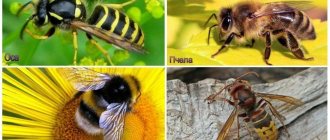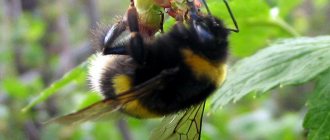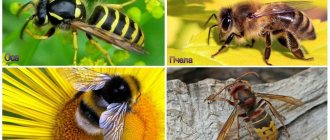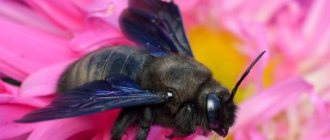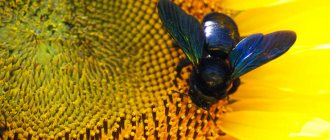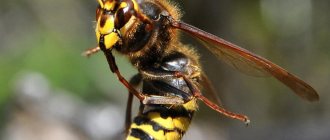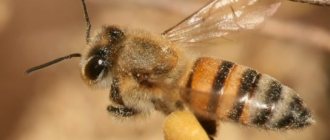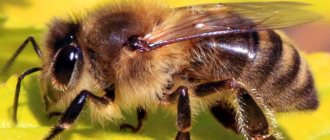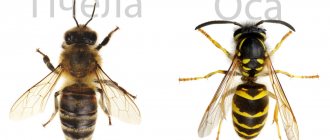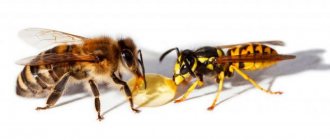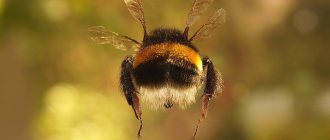Among the insects flying in the meadow, there are three genera that a person encounters quite often in his life: the bee, the wasp and the bumblebee. It's difficult to confuse them. They vary greatly in color and size. But sometimes this is possible if you do not delve into the details of the color of a large insect that has flown into the window. We are accustomed to the fact that the bumblebee is the largest of these three species, but the predatory wasp - the hornet - is much larger, and the body length of some bumblebees is less than that of a bee. Therefore, you will have to understand in more detail how a wasp, a bee and a bumblebee differ from each other, and how they are similar.
Similarities
All three groups belong to the Hymenoptera family. Wasps, bees, and bumblebees are social insects and build nests. All three have stingers. Families are divided into queens, workers and male drones. After fertilization of the female, the workers expel the male parasites. They defend their nests by attacking the whole family.
Bees and bumblebees belong to the family of true bees and can make honey. Bumblebee honey is superior in quality to bee honey, but cannot be stored for a long time. Both genera of these insects are beneficial plant pollinators.
Bumblebees also have a smooth sting that they can use repeatedly. Many bumblebees have almost the same body coloration as paper wasps.
This is where the similarities end. Now let’s talk about how a wasp, a bee, and a bumblebee differ from each other.
Body measurements
In nature, there are species whose body length is almost the same, so using this characteristic it can be difficult to distinguish who is who. Despite this, general dimensions and body structure can indicate who we are talking about. This is another sign of how these insects can be distinguished.
Important fact! Despite the length of the body, the representative of the Bombus species always looks more massive than the graceful bees and wasps.
Differences
Bee, bumblebee and wasp
There are much more signs by which you can determine who is flying around. Using them, it is unmistakably possible to recognize whether an insect belongs to a particular family.
In the first place is “hairiness”. In terms of hairiness, the rating of insects looks like this:
- Bumblebee.
- Bee.
- Wasp.
Large wasps and small bumblebees are easy to confuse even by color. Among these unrelated insects, there are species that are similar in color and arrangement of markings. But wasps are always “bald”.
The bee occupies an intermediate place in terms of hairiness and often also appears “bald” to the inattentive observer. In fact, it has bristles, but they are short and sparse.
Bite differences
Wasps, being the most aggressive, often use their stings. A wasp sting is quite painful. In addition, they are quite capable of biting with their powerful jaws (they will not bite through human skin, but such a bite is more than enough for small insects)
The wasp's sting is smooth and does not remain in the wound, which can lead to a repeated attack. This does not harm her health. The poison provokes severe swelling and burning, accompanied by severe pain.
Bees use their sting for defense only as a last resort. They can only sting once, causing harm to themselves and death. The sting has serrations, it remains at the site of the bite with the back part of the body torn out (a bag of poison, which, even after the death of the bee, continues to shrink for another 15-20 minutes). The pain is not as severe as with a wasp sting. There are no other significant differences in the bites of wasps and bees.
During an attack, wasps and bees signal danger to their relatives, who all attack the offender together. Bumblebees can also behave this way, but since they often fly alone, in the event of a conflict, you only have to deal with one individual.
The bite of a bumblebee is much stronger than that of a wasp and a bee, but somewhat weaker than that of a hornet. The smooth sting does not remain in the wound. Only female bumblebees can sting.
Coloring
It is quite easy to distinguish a bee from a bumblebee and a wasp by the degree of color: the first is always dark brown. The stereotype of striped honey collectors comes from cartoons. You can compare photos of a bee and a bumblebee. The differences will be immediately noticeable.
The other two insects can have not only striped, but also almost uniform coloring. For example, glitter wasps are iridescent, and typhias are solid black. But usually people only consider wasps to be insects with black and yellow stripes on their bodies. This does not prevent representatives of other families from also biting painfully and sometimes being more dangerous.
What they look like
To be able to easily recognize an insect, you need to know what they look like, each of them has its own distinctive appearance characteristics, let’s get acquainted with them:
- Bee. They are distinguished by the most modest color. There is no sharp transition between the chest and abdomen, the body is shaggy. They have fairly thick legs, which are covered with hairs, and have small jaws.
- Wasp. We all know about the term “wasp waist” and this really only applies to this type of insect; there is a sharp transition between the abdomen and thorax. The body is more elongated and smooth. It has a fairly bright color of the body, there are bright yellow splashes on the black back, and the abdomen is painted with contrasting bright yellow and black stripes. The paws are yellow. The oral apparatus is equipped with fairly powerful mandibles.
- Bumblebee. It has a more impressive body size; its distinctive characteristic is the fluffy cover throughout the body. He also has a beautiful, bright color, has yellowish-red stripes, maybe with a red tint. Bumblebees are found in nature completely black.
- Hornet. They are the largest representatives, their body size can reach 5 cm. They are also distinguished by fairly large and powerful jaws. Outwardly, it resembles a wasp, but the striking difference between the hornet is the absence of a thin waist.
Diet and storage of supplies
Bee, bumblebee and wasp
Here the greatest differences are observed between these three representatives of the order Hymenoptera. The family of true bees are vegetarians and feed on nectar and pollen from flowers. Wasps are omnivores with a bias towards predators and scavengers.
The difference between a bee and a bumblebee in this area is that the former make provisions for the winter and leave for the winter with the whole family. The second needs honey only for feeding the larvae. Of the entire bumblebee family, only the queen remains for the winter. Therefore, although they know how to make honey, bumblebees do not prepare it and use it only for feeding larvae.
Wasps can eat:
- ripe fruits;
- jam;
- insects;
- carrion.
They feed the larvae with protein food. To do this, in nature, workers catch insects, including green corpse flies. In urban environments, they bite off small pieces of meat at the market or find the corpse of a dead animal.
They do not make reserves for the winter, since the entire aspen family dies out in the fall, and only the queen “leaves” for the winter.
What is the difference between a bumblebee and a bee?
Regardless of the similarity of a bee and a bumblebee in the structure of their wings, there are many factors that distinguish them. The bumblebee and the bee are close relatives. Their habitat is very extensive. There are about 300 species of bumblebees living throughout the continents. A distinctive feature of this species is the shiny covering of the female's hind legs from the fold to the edge, covered with long hairs that form a basket for collecting pollen. The abdomen is round, not bent, the segments are hard, the organs of the reproductive system are dark in color. The internal structure of the sting is tubular. The poison passes through this channel after penetrating the skin of the sting, the upper structure of which is without notches, due to which the injections are made repeatedly, without harm to the insect itself.
There are about 300 species of bumblebees from about 50 subgenera known in the world.
The bee family has more than 20 thousand species, many of which have not been studied. They are the main pollinators and pollen collectors, honey producers. There are three pairs of legs on the abdomen, with villi on the inside. On the hind legs, villi form baskets for collecting pollen. The abdomen consists of dense segments, bent to the bottom. The sting is empty inside, the upper covering of the sting is with notches, which, when bitten, are hooked by the barbs onto the edges of the puncture. After tearing off the sting with a piece of the abdomen, the insect soon dies.
There are about 21 thousand species and 520 genera of bees
The difference between a bee and a bumblebee can be determined visually:
- A bumblebee is twice as large as a bee, its body is round.
- The coloring of a bumblebee is brighter than that of a bee.
- Bees are used on farms to collect pollen and pollinate plants in gardens and fields in open areas, bumblebees are used to pollinate plants in greenhouses.
- Sting Use - A bumblebee uses its sting many times. The bee only dies once.
Nests
A family of real bees, in the absence of ready-made artificial hives and bumblebees, finds a suitable cavity and begins to build honeycombs there. Their nests do not have a specific shape, as they depend on the cavity in which the queen has settled.
The most common and familiar to us, real wasps, at the sight of which people are not mistaken about the identity of the insect, build nests on their own. In Russia, two types of wasp nests can be found: a vertically elongated top (the kind they draw in cartoons) and a curved “plate” of irregular shape. The “plate” resembles a sunflower core from which the seeds have been removed.
Important!
The “extended top” may turn out to be a nest of hornets.
Wasps build their nests from chewed cellulose glued together with saliva. The structure of the nest material is very similar to thick paper.
Insect nests
bumblebees
Bumblebees are very similar in appearance to bees, only larger, reaching 2.5 centimeters in length. They buzz very loudly. The color of individuals is black with yellow stripes; they are also found with red and orange stripes. The body is covered with hairs and it looks very shaggy, thanks to these hairs it pollinates plant flowers. There are two transparent wings on the back.
Bumblebees live in earthen nests, 300 individuals in one family. Bumblebees feed on nectar and pollen, just like bees produce honey, but it is not used in human nutrition. Their sting is short in length and has no serrations. Uses it many times for his protection. Their bites are very dangerous to health.
Stings
The bee has serrations and a “lock” on the tip. This prevents the stinger from being removed from the victim's body. Therefore, the worker defending the nest dies after the attack. For this reason, bees attack themselves only if you climb into their hive.
Insects can easily remove bumblebee and wasp stings from the victim and use them again. The pain from a bumblebee, wasp and bee sting directly depends on their size. Moreover, the wasp often bites “just like that.” With a bumblebee, you have to try really hard to get it to sting.
Who bites harder?
People quite often become victims of stinging insects, and therefore the question often arises of who bites more painfully: wasps, bees, bumblebees or hornets.
The most aggressive are wasps and hornets. These insects have a smooth sting with which they can pierce the skin of their prey several times. Moreover, the offender himself is in no danger in such a situation. A hornet and wasp sting is accompanied by severe pain, a burning sensation and swelling. Hornet venom (especially Japanese venom) has a more toxic composition. The consequence of such an attack can be a severe allergic reaction, and even death.
A bee is capable of stinging once, since it leaves its sting in the body of the victim. The attack weapon is prevented from coming back out by the barbs, as a result of which the insect loses some part of its body and soon dies. Therefore, bees sting only in exceptional cases. If you look for the difference in who stings harder, then a bee sting is less painful than a wasp or hornet. In addition, when danger arises, both bees and wasps are capable of sending a distress signal to their relatives, as a result of which the entire swarm attacks the offender.
Bumblebees are less conflicting in this regard and attack their prey in exceptional cases. However, if we compare who stings more, or rather who stings more painfully between a bee, a wasp and a hornet, then the bumblebee will occupy third position in this list.
The danger of a bee, wasp, bumblebee, and especially a hornet sting increases significantly for people with allergies. However, if you are careful and know what a dangerous offender looks like, it is not difficult to avoid unpleasant situations.
It is difficult to imagine nature without insects that crawl, fly, and buzz. They are attracted by the aroma of flowers, the sweet smell of fruits and berries. Many people have experienced the pain of being bitten by a buzzing insect. How dangerous are they for people and how can they be distinguished by their appearance? What could be the consequences of the poison entering the victim’s body?
Behavior
Bumblebee is a loner. If disturbed, it will fly away. Representatives of the genus Bombus attack only if the nest is in danger.
A solitary worker bee can sometimes hover around an object, determining the degree of its danger to itself. But it won’t sting if you don’t wave your arms or make sudden movements. They attack together only when attacking a hive.
The wasp is the most quarrelsome and annoying creature of all three. Can hover around an object for a long time. And it often stings because “I want it that way.”
Bees
Bees are insects that have been domesticated by humans. Individuals are colored yellow-black with stripes. The insect consists of two parts - the abdomen and thorax, which are of the same size.
The body is covered with villi. There are transparent wings on the back. They live in specially built hive houses. In the wild, they inhabit tree hollows. Bees live in huge swarms, building honeycombs. They fly through flower meadows and collect pollen and nectar, feed on them and produce honey from them, which is very useful for our body. Individuals are very hardworking. Thanks to them, the flowers of fruit plants are pollinated, thereby helping to increase productivity.
There is a sting in the abdomen area, which is located next to the poisonous glands. With its help, they protect themselves from ill-wishers. After biting a person, she cannot stick the sting out of the skin, since it has serrations and therefore dies. The body of the bitten person becomes poisoned from the released poison, in some cases causing a complex stage of allergy (anaphylactic shock).
If they suddenly disappear
Ecologists around the world are sounding the alarm, pointing to a decline in the number of bee and bumblebee families. If you imagine that wasps, bumblebees, and bees suddenly disappeared, then hardly anyone will notice the absence of the former. Their place will be taken by other lovers of insects and carrion. It doesn't make much difference who will destroy the pests. However, we should not forget that in addition to harm, wasps bring benefits, just like their relatives.
But humanity will immediately feel the disappearance of pollinators. Without bees, the pollinators of a significant part of fruit trees and shrubs, and bumblebees working on clover and in greenhouses, humanity will suffer famine. But scientists don’t yet know what to do about the decline in pollinator numbers.
Features of the genus
So who are the hornets? The genus Hornets belongs to the family of true wasps. That is why representatives of this genus fit well into the external framework inherent in ordinary wasps. At the same time, there are some differences that will not allow these, albeit close, but still different taxonomic groups of Hymenoptera insects, to be confused.
Stinging insects.
What does a hornet look like next to a wasp? Large hornets differ from other wasps primarily in their large size. The dimensions of an insect such as a hornet range from 1.8 to 5.5 cm in length, depending on the species. Also, the wingspan of these largest wasps in the world can reach 8 cm. And this large wasp, in addition to its serious dimensions, has very powerful and impressive jaws, which also differs from most other wasps.
Among the differences between representatives of the hornet genus and other wasps, some differences in color should also be mentioned. The hornet insect has the same striped abdomen as most wasps. Moreover, if the color of the wasp is dominated by only two colors, namely black and yellow, then the color of the hornet is somewhat darker, and orange and brown shades have found their place in the color palette.
Well, we cannot ignore that unpleasant part of the story about this huge wasp, which concerns the main weapon of these stinging hymenoptera. It’s no secret that wasps tend to use their sting for its intended purpose in case of danger.
Although, it must be said that the wasp’s sting performs not only the function of an injection needle for treating a presumptuous enemy with a portion of poison. It is also a reduced insect ovipositor.
Therefore, such cinematic epithets as “murder hornets” are often and, it must be said, not unreasonably used in relation to these not very cocky, but certainly capable of standing up for themselves insects.
Just wondering
Finally, some interesting facts about bees, wasps and bumblebees:
- After the queen is fertilized, the bees attack the drones and drive them out of the hive forever. “When free,” the drones quickly die, since they cannot obtain food for themselves.
- Wasps make honey, but few have seen it. This almost microscopic droplet at the bottom of the new cell is needed by the larva only for the first time, until it becomes able to consume protein food.
- Bumblebees wake up earlier than everyone else and are the first to collect nectar.
- The hornet is a predator that prefers live prey.
- A worker bee can tell family members the way to a food source.
All these insects are very interesting, if you do not treat them as annoying and unnecessary creatures. They do more good than harm, and they should not be destroyed unless absolutely necessary.
Where can you find insects
© Getty Images Pro
Bees
live in large families in hives. They are most often found near flowers, but they also like to live in hollow trees, abandoned rodent burrows, wooden objects and roofs.
bumblebees
They live in small families, usually on the ground or in empty bird nests.
Wasps
They live in families, usually on the ground or under roof space, and their nests can often be found in places such as gutters, bushes and areas along fences. Wasps love meat, so if you barbecue, they may fly onto the meat.
Hornets nests
can be on trees, bushes, hanging from eaves and even poles. Since they are a type of wasp, they also love meat.
General characteristics of the OS
The body length of the insect is from 1 to 10 cm. The body is divided into the head and abdomen, covered with fluff. The antennae perform various functions: tactile, olfactory and visual, and also act as a taste receptor. From the slightest air movements, the antennae receive important information about the possibility of finding food, danger, and much more.
The eyes are characterized by extremely complex physiology. The powerful oral apparatus allows you to eat even solid food, grinding its particles. It also serves to build a nest. Most wasps are social insects. The design features of wasp nests consist of the presence of honeycombs, and this is reminiscent of bee hives. The basic characteristics of the lifestyle of these two insects are similar. Nests are built by females, and subsequently the entire colony takes care of the offspring.
Each individual in the family has its own responsibilities and characteristics. The queens begin building the foundation for the future nest. The raw material for construction is wood. The wood particles of the wasp are thoroughly chewed, mixed with saliva, which has adhesive properties. This building material is intended for the construction of honeycombs, which will then be attached to the surface that, in the opinion of the queen, is best suited. When the material dries, it forms a thin paper.
The main feature of the insect is the sting, through which the poison enters the body of the victim. Most often, an attack is explained as a defensive reaction to potential danger. Bites cause severe pain, swelling and allergies.
Nest arrangement
If we talk about domestic bees, beekeepers build nests for them, in the form of hives. Wild ones build nests on their own; they can be located in tree hollows or rock crevices.
Wasps use wood as a building material to build nests; they chew it, which makes it possible to obtain pliable material for building a nest. It is round in shape and gray in color and resembles paper in appearance. More often they are found on tree branches, they can set it up under the ceiling of outbuildings, some species set it up in the ground.
Bumblebees can choose completely different places to build nests, most often the burrows of small animals and abandoned bird nests. Bumblebees begin building their house from wax, namely the first cells; for subsequent cells they use capsules that remain from hatched larvae.
